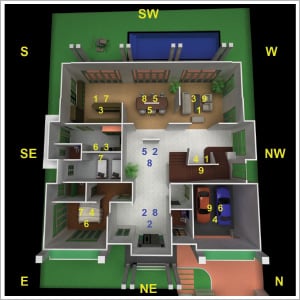 One of the most vital aspects in residential design is to understand the flow of chi in the living space and how to derive a design concept that match your daily needs. To effectively conceptualize requires thorough understanding of the basic rules of space planning – i.e. viewing living requirements as living zones within the space. While there are many techniques to create zones within the home, a good template is to consider using the compass axis based on the flying star formula – this provides an excellent starting point to arranging space layout in the home.
One of the most vital aspects in residential design is to understand the flow of chi in the living space and how to derive a design concept that match your daily needs. To effectively conceptualize requires thorough understanding of the basic rules of space planning – i.e. viewing living requirements as living zones within the space. While there are many techniques to create zones within the home, a good template is to consider using the compass axis based on the flying star formula – this provides an excellent starting point to arranging space layout in the home.
What is the feng shui compass axis? The term denotes zoning lines that create a center of attraction and allow adjacent spaces to tap or enjoy such spaces. In this case, we use the flying star chart of your home to identify centers of good fortune and then formulate a design concept around them.
Take a Northeast 1 facing house as an example. The chart of this house is shown below. Here we can identify the 3 auspicious centers of the home, which are the Northeast corner with the water star # 8 (wealth luck), the Southwest sector with mountain star # 8 (relationship luck) and the Northwest with the 4,1 star combination.
 We can create axis lines by plotting vertical and horizontal lines from the 3 key sectors as vital parts of the home. This allows us to identify the adjacent areas that can benefit from the energies of the 3 auspicious areas. From here we can maximize space planning within the home and we can also see how best to rearrange the rooms to maximize the flow auspicious chi from room to room.
We can create axis lines by plotting vertical and horizontal lines from the 3 key sectors as vital parts of the home. This allows us to identify the adjacent areas that can benefit from the energies of the 3 auspicious areas. From here we can maximize space planning within the home and we can also see how best to rearrange the rooms to maximize the flow auspicious chi from room to room.
In this Northeast facing layout, the Northeast corner is reserved for the main door as this reflects the mouth or entrance portal into the home. The Southwest corner is designated as the main family area, either the living or dining room. While the Northwest corner, which also represents the sector of the patriarch, plays a vital role in inviting the energy to the upper levels thus the location of the staircase.
An open space plan concept as shown above will allow the 3 auspicious zones to expand their influence to adjacent sectors. In the Northeast, the foyer is enlarged to allow auspicious incoming energies to circulate and settle before flowing to other sectors. A double volume space is introduced here to serve as a conduit to channel the potent energies to all levels of the home.
The central portion of the house is dedicated mostly to services and a transition zone, where it separates yet links the front and back portions together. The stairs located in the Northwest help to take advantage of the #1 wealth water star, by channeling the good star combinations to the upper levels while enhancing the patriarch corner to strengthen the luck of the father. Broad windows are located here to pull in sunlight, creating a vibrant yang atmosphere within the transition zone of the home.
The main living area in the Southwest, otherwise known as the matriarch corner, represents the heart of the family home. Through an open plan, you want to maximize the potential of the sector by expanding the central zone such that it dominates the entire back sector. This allows the energies of the water star #8 to rule over the adjacent corners in the West and South.
The breakfast/ kitchen area is placed in the South corner as a strategic spot to serve several purposes. By being in the South, it allows the main workflow of kitchen to dining and living areas to be in an organized manner. It also acts as a central focus of attraction between the indoor and outdoor dining thus creating a flow of activity. Feng shui-wise, it brings the Fire energy of the stove to enhance the strength of the South bringing a good name, fame and opportunity luck. With fire energy present, it also helps to control the # 7 water star of the South.
 The Open Plan
The Open Plan
By using partitions, the open plan concept allows the expanse of space through visual perspective yet in a subconscious manner creates an invisible barrier that helps demarcate the use of individual space zones. In this example, it illustrates the concept of combining the dining with living areas to expand the effects of the Southwest flying star, yet maintaining each area’s privacy.
There are many different ways to plan space around the house and there are plenty of different configurations that can work. Some may want to explore the concept of form and shape to create an architectural masterpiece; others may take a more down to earth pragmatic approach. Whatever and however you wish to design your space, it is beneficial to use the template provided by the current flying star chart of your home. This is the best way to ensure that feng shui wise, the key energies of the current period are incorporated into your space planning.






















